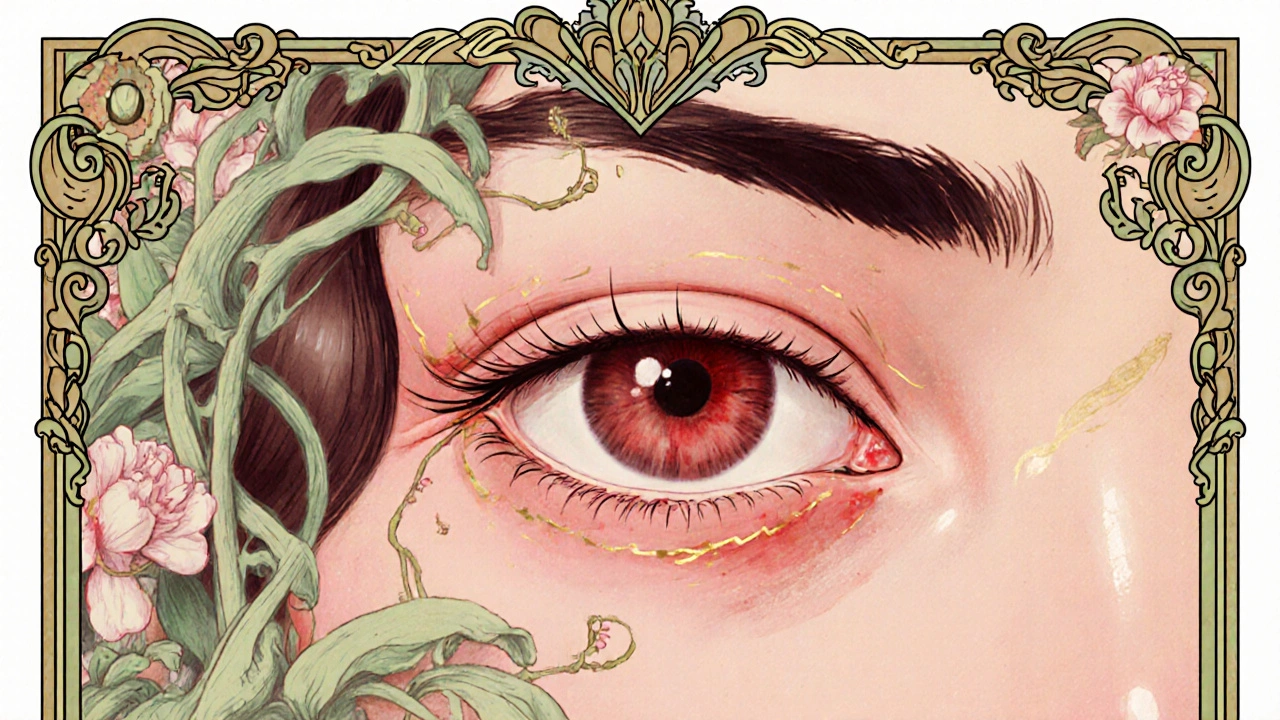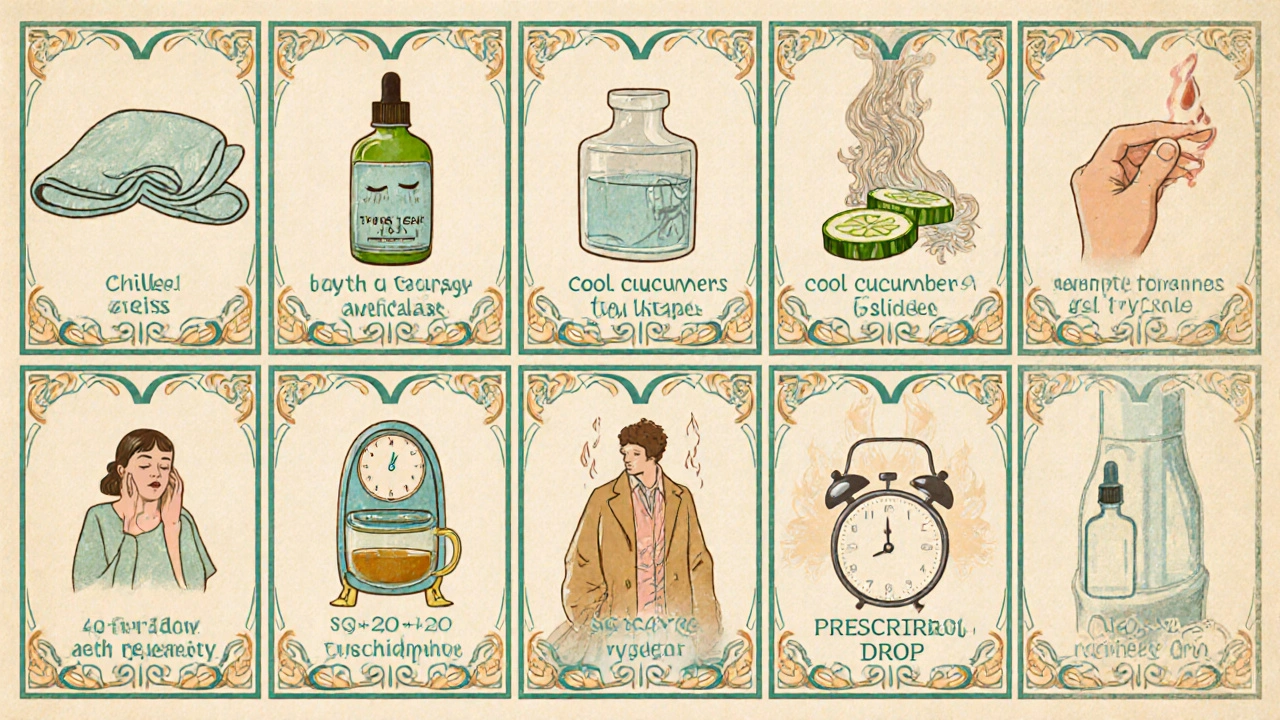Top 10 Remedies for Reducing Eye Redness

Oct, 23 2025
When your eyes look bloodshot, eye redness is a common symptom where the white part of the eye (sclera) turns pink or red due to dilated blood vessels. It can be annoying, make you look tired, and sometimes signal an underlying issue. Below you’ll find the ten most effective remedies you can try at home or pick up at the pharmacy, plus tips on when a doctor’s visit is warranted.
Quick Takeaways
- Identify the cause - allergies, dryness, irritation, or infection - before choosing a remedy.
- Cold compresses and artificial tears work for most mild cases.
- Antihistamine eye drops are the go‑to for allergy‑related redness.
- Prescription drops are needed for bacterial or severe inflammatory causes.
- Preventive habits (screen breaks, humidifier use) keep redness at bay.
What Causes Eye Redness?
Understanding why your eyes are red helps you pick the right solution. The most common triggers include:
- Allergic conjunctivitis - pollen, pet dander, or cosmetics trigger histamine release.
- Dry eye syndrome - insufficient tear production or poor tear quality.
- Contact lens irritation - deposits, poor fit, or extended wear.
- Environmental factors - smoke, wind, low humidity, or bright light.
- Eye strain - long screen time reduces blink rate, leading to redness.
- Infection - bacterial or viral conjunctivitis often adds discharge and crusting.
When to See a Professional
Most redness clears with simple home care, but you should schedule a visit if you notice any of the following:
- Severe pain or light sensitivity.
- Sudden vision changes or double vision.
- Thick yellow or green discharge.
- Redness lasting more than a week despite self‑care.
- History of glaucoma, eye surgery, or chronic eye disease.
A clinician can rule out serious conditions and prescribe the appropriate medication, such as corticosteroid drops or antibiotics.

Top 10 Remedies for Reducing Eye Redness
- Cold Compress - Soak a clean washcloth in chilled water, wring out excess, and place over closed eyes for 5‑10 minutes. The cold narrows blood vessels, quickly easing the pink hue. Use 2-3 times a day; avoid ice directly on the skin.
- Artificial Tears - Over‑the‑counter lubricating drops (e.g., Refresh, Systane) replenish the tear film. Choose preservative‑free formulas if you need frequent dosing. Apply 1-2 drops every 2-3 hours for dry eye‑related redness.
- Antihistamine Eye Drops - Products like Zaditor or Pataday block histamine receptors, reducing allergic swelling. They work within minutes and last up to 12 hours. Use twice daily during high‑pollen seasons.
- Cucumber Slices - Chill fresh cucumber, cut ¼‑inch rounds, and rest them on each eye for 10 minutes. Cucumber’s cool moisture and flavonoids soothe irritation, especially after a long flight or beach day.
- Chamomile Tea Bags - Steep two tea bags, chill, then place on closed lids for 5-7 minutes. Chamomile’s anti‑inflammatory properties calm mild conjunctivitis. Ensure the tea bags are plain, without added oils.
- Aloe Vera Gel - Use a sterile, pure aloe gel (no fragrance) and dab a tiny amount onto the inner eyelid margin with a clean cotton swab. Aloe’s soothing peptides reduce redness from minor burns or wind exposure.
- Blink Exercise - Every 20 minutes of screen work, pause and blink deliberately 10 times. This refreshes the tear layer and prevents the “dry eye” loop that fuels redness.
- Screen Time Reduction & 20‑20‑20 Rule - Every 20 minutes, look at something 20 feet away for 20 seconds. It lowers eye strain, decreases vascular dilation, and cuts redness.
- Humidifier Use - Run a cool‑mist humidifier at night to keep indoor humidity between 40‑55 %. Moist air prevents tear evaporation, a key factor in chronic red eyes.
- Prescription Eye Drops - If OTC options fail, a doctor may prescribe anti‑inflammatory drops (e.g., prednisolone) or antibiotic drops for bacterial conjunctivitis. Follow the exact dosing schedule to avoid rebound redness.
Remedy Comparison Table
| Remedy | Type | How it Works | Pros | Cons |
|---|---|---|---|---|
| Cold Compress | Home | Vasoconstriction reduces blood flow | Instant relief, no cost | Temporary, needs repeat |
| Artificial Tears | OTC | Lubricates tear film | Safe for frequent use | Preservatives may irritate some |
| Antihistamine Drops | OTC | Blocks histamine receptors | Effective for allergies | May cause mild stinging |
| Prescription Drops | Prescription | Targets inflammation or infection | High efficacy for serious cases | Requires doctor visit, possible side effects |

Preventive Habits to Keep Redness at Bay
Even after the redness clears, a few daily habits can stop it from coming back:
- Stay hydrated - water helps maintain tear production.
- Wear sunglasses outdoors to shield eyes from UV and wind.
- Replace contact lenses as prescribed; avoid sleeping in them.
- Keep makeup brushes clean; old residue can trigger irritation.
- Limit alcohol and caffeine, which can dehydrate the eyes.
Common Mistakes to Avoid
While it’s tempting to self‑treat, some shortcuts backfire:
- Rubbing the eyes - this spreads irritants and can damage corneal cells.
- Using expired eye drops - preservatives break down, increasing infection risk.
- Sharing eye drops with others - bacteria can spread.
- Skipping a doctor’s visit for painful or sticky eyes - you might need antibiotics.
Frequently Asked Questions
Can I use regular water for a cold compress?
Yes, but make sure the water is clean and not ice‑cold. A washcloth soaked in cool tap water, then wrung out, works well and avoids skin damage.
How often should I apply artificial tears?
For mild dryness, one to two drops every 4‑6 hours is enough. If you work at a computer all day, you can use them every 2‑3 hours without harm.
Are antihistamine eye drops safe for children?
Most OTC antihistamine drops are labeled for ages 3 and up. For younger kids, ask a pediatrician; they may recommend a prescription formula.
Can a humidifier cure red eyes?
A humidifier won’t cure an infection, but it can relieve dryness‑related redness by keeping the air moist, especially in winter heating season.
When should I stop using over‑the‑counter drops and see a doctor?
If redness persists beyond 7‑10 days, worsens, or is accompanied by pain, discharge, or vision changes, schedule an appointment. Persistent symptoms may need prescription medication.
By matching the remedy to the cause, you can calm eye redness fast and keep your eyes looking clear and comfortable. Remember, a little prevention goes a long way, but don’t hesitate to get professional care when needed.
